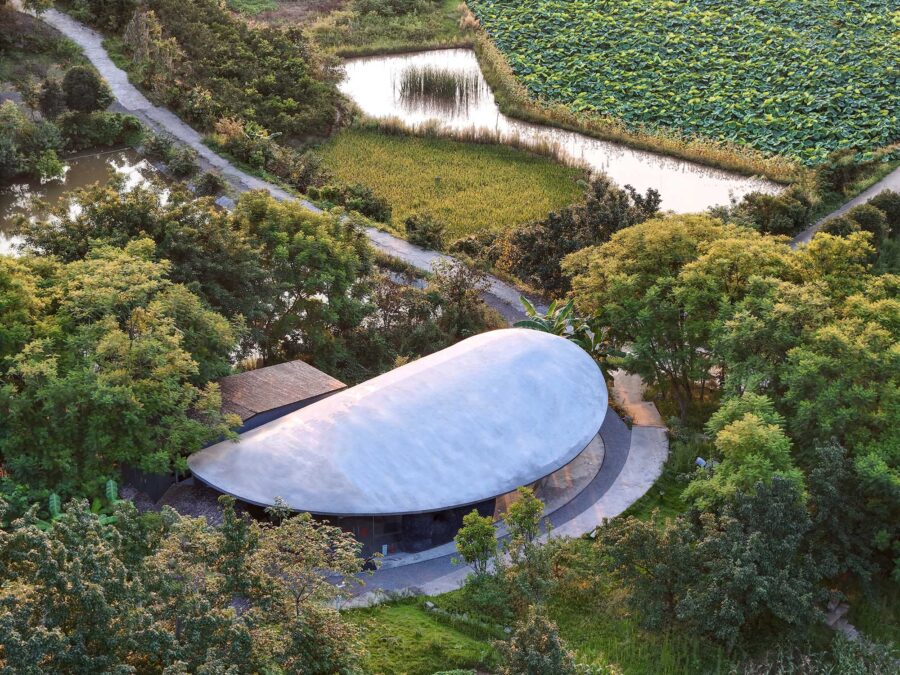
CULTURE


© Julian Krüger, Benjamin Kemper
ドイツのヴィスマールに建てられた〈デジタルハウス(Digital house)〉は、各接合部を取り外し可能なものとする「プラグイン工法」による、工具や金具を一切使わずに組み立ても解体も可能な木造建築です。
CNC加工した24mmの合板や、パラメトリック・デザインが施されたリサイクルアルミシートなどで構成されており、2人でも素早く組み立てることが可能となっています。ミュンヘン応用科学大学のユリアン・クリューガー(Julian Krüger)とヴィスマール応用科学大学のベンジャミン・ケンパー(Benjamin Kemper)が設計しました。
CNCによるデジファブ建築特集 | 樹木のような構造体や完璧な音響など デジタルデータを元に部材を生成する「CNCマシン」による 5つのプロジェクト
(以下、Julian Krügerから提供されたプレスキットのテキストの抄訳)

© Julian Krüger, Benjamin Kemper
北ドイツの歴史的な都市ヴィスマールにて、建築とデジタルファブリケーションの斬新なアプローチが登場した。この革新的なプラグイン工法に基づいた、持続可能で費用対効果の高い建築システムは、ユリアン・クリューガー(ミュンヘン応用科学大学)とベンジャミン・ケンパー(ヴィスマール応用科学大学)により開発された。
プラグイン工法(plug-in construction):釘やネジを使わずにすべての部材を差し込む構造原理。伝統的な日本の木造建築のディテールにヒントを得てつつ、梁の代わりに24mmの合板を使用しており、すべての接合部や接続部は、工具や留め具を使わずに組み立て・分解が可能。

Detail

© Julian Krüger, Benjamin Kemper
ヴィスマール大学・建築デザイン学部の校舎からほど近い木立の中に、銀色に輝くファサードと西向きの急勾配な片流れ屋根をもつ高さ6.5m、3.3×4.9mの小さな家が建っている。
広々とした室内には、リサイクルアルミシートでつくられたファサードを貫く水平窓や大きな田の字の窓から光が入る。

© Julian Krüger, Benjamin Kemper
工具も金具も使わず、組み立ても解体も容易にする木造建築システム
この住宅は、24mmの合板をCNC加工した独自の木造建築システムを採用しており、ネジや釘などの工具や金具を一切使わずに、2人で素早く組み立てることができる。
解体して再利用することも可能にするこのフレキシブルなシステムは、プロジェクトの持続可能性へのアプローチを強化している。木造構造の内部は合板パネル、外部は透湿性のある木質繊維板で覆われ、環境に優しい木質繊維による断熱が施されている。〈デジタルハウス〉は、6本のグラウンドスクリュー杭で地面に固定されており、コンクリートや地盤工事を必要せず、素早く跡形もなく解体することができる。

© Julian Krüger, Benjamin Kemper
留め具を使わず構造体に取り付けられるアルミのファサード
建設されたプロトタイプは、パラメトリック・デザインが施されたリサイクルアルミシートのファサードに包まれている。建物全体を包み込む、コンピュータにより出力された水平エレメントは、開口部周辺では構造体に密着し、開口部のない部分では扇状に広がっている。
レーザーカットされたアルミシートには、構造体に固定するために必要な留め具のディテールが含まれており、窓とドアもプラグイン工法の原理に従い、24mmの合板パネルからCNC加工されている。

© Julian Krüger, Benjamin Kemper
アプリでのカスタマイズを目指す建築システム
この建築システムは、住宅の形状や機能をアプリでカスタマイズすることを可能にする、将来のパラメトリック・プランニングのために最適化されている。
このパラメトリック・プランニングにより、ユーザーは建物の形状、間取り、屋根、開口部、ファサードを特定のニーズに合わせてカスタマイズし、小規模な独立した建築物や都市部での高密度なプロジェクトを建設することができるようになる。

© Julian Krüger, Benjamin Kemper
建築をサステナブルなものとするための統合的な取り組み
このプロジェクトは、デジタルプランニング、効率的な生産、再生可能素材やリサイクル素材の最適な利用が、サステナブルな建築にいかに貢献できるかを証明している。
建築とファサード・システム用のパネル材を選択することで、CNCフライス盤とレーザー加工機を使用した、完全自動化されたコスト効果の高い部品の製作が可能となった。これにより、計画から生産、現場での組み立てまで、シームレスなプロセス・チェーンを実現できる。
〈デジタルハウス〉は、開発・製造段階における統合的アプローチが、基本設計、詳細設計、製造、建設という従来の領域間の境界をますます曖昧にし、デジタルデザインと製造方法が建築生産に与える潜在的な影響を示している。

© Julian Krüger, Benjamin Kemper

© Julian Krüger, Benjamin Kemper

© Julian Krüger, Benjamin Kemper

© Julian Krüger, Benjamin Kemper

© Julian Krüger, Benjamin Kemper

© Julian Krüger, Benjamin Kemper

© Julian Krüger, Benjamin Kemper

© Julian Krüger, Benjamin Kemper

Axonometric © Julian Krüger, Benjamin Kemper

© Julian Krüger, Benjamin Kemper

© Julian Krüger, Benjamin Kemper

© Julian Krüger, Benjamin Kemper

© Julian Krüger, Benjamin Kemper

Section © Julian Krüger, Benjamin Kemper
以下、Julian Krügerのリリース(英文)です。
DIGITAL HOUSE
Infotext
A novel approach to digital fabrication in architecture has emerged in Wismar, a historic Hanseatic city in Northern Germany, with the creation of the “Digital House” – a prototypical building entirely digitally designed, fabricated, and assembled without the need for tools.
Julian Krüger (Munich University of Applied Sciences) and Benjamin Kemper (Wismar University of Applied Sciences) developed a sustainable, cost-effective building system based on innovative plug-in construction methods.In a grove not far from the Faculty of Architecture and Design at Wismar university, a small house with a shiny, silvery facade and a steep, west-facing mono-pitch roof stands 6.5 m high on a footprint of 3.3 × 4.9 m. Light enters the spacious interior through a continuous window ribbon and four large windows cutting through the facade made from recycled aluminium sheets.
The house features an inventive wood construction system CNC-milled from 24mm plywood, allowing two people to assemble it quickly without any tools or hardware, such as screws or nails. This flexible system, which allows for disassembly and reuse, strengthens the project’s approach to sustainability. The wooden structure is clad with plywood panels inside and a vapour-permeable wood fibreboard on the outside and insulated with eco-friendly wood fibre.
The “Digital House” rests on six ground screws, enabling quick and traceless disassembly and eliminating the need for concrete or groundwork.
The prototype showcases a parametrically designed facade made of recycled aluminium sheets. The computer-generated horizontal elements wrap the entire building, laying close to the structure around the openings and fanning out over the closed areas. The aluminium sheets are laser-cut and contain all the required fastening details, which are folded out and attached to the sub-construction.
The windows and the door of the “Digital House” also follow the plug-in construction principle and are CNC-milled of 24 mm multiplex panels.The building system is optimised for future parametric planning. This allows for app customisation of the house’s form and function. Users can personalise the building’s shape, floor plan, roof, openings, and facade to their specific needs to either build small standalone structures or densification projects in urban areas.
The project highlights how digital planning, efficient production, and the optimised use of renewable and recycled materials can contribute to sustainable building. The selection of panel materials for the construction and facade systems allows for a fully automated, cost-effective fabrication of the parts using CNC milling and laser machines. It ensures a seamless process chain – from planning, production to on-site assembly.
The “Digital House” demonstrates that an integrative approach in the development and fabrication phases increasingly blurs the boundaries between the traditional areas of preliminary design, detailed design, fabrication and construction and shows the potential impact of digital design and fabrication methods on architectural production.
CREDITS
Funding:
German Federal Ministry for Economic Affairs and Climate Action (BMWK)Planning & design:
Julian Krüger, Munich University of Applied Sciences
Benjamin Kemper, Wismar University of Applied SciencesManufacturing:
Bächer Bergmann GmbH
BCK Metallverarbeitung GmbHIndustrial partners:
STEICO SE
FRITZ EGGER GmbH & Co. OG
Speira GmbH
Gerflor Mipolam GmbH
ABUS August Bremicker Söhne KGCosts:
33 000 €Construction time:
2 weeks









